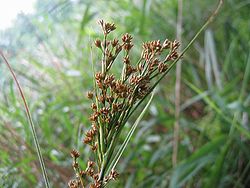| Cladium mariscus | |
|---|---|
 | |
| Scientific classification | |
| Kingdom: | Plantae |
| Clade: | Tracheophytes |
| Clade: | Angiosperms |
| Clade: | Monocots |
| Clade: | Commelinids |
| Order: | Poales |
| Family: | Cyperaceae |
| Genus: | Cladium |
| Species: | C. mariscus |
| Binomial name | |
| Cladium mariscus | |
| Synonyms | |
| |
Cladium mariscus is a species of flowering plant in the sedge family known by the common names swamp sawgrass, [1] great fen-sedge, [2] saw-sedge or sawtooth sedge. Previously it was known as elk sedge.[ citation needed ] It is native of temperate Europe and Asia where it grows in base-rich boggy areas and lakesides. It can be up to 2.5 metres (8 ft 2 in) tall, and has leaves with hard serrated edges. [3] In the past, it was an important material to build thatched roofs; harvesting it was an arduous task due to its sharp edges that can cause deep lacerations. [4]